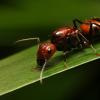About a week back I bought 1 C.sansabeanus queen from antopiausa and then I went down to san jose and found another.
queen A: 10 eggs 2 larva
queen B: 7 eggs 3 larva

About a week back I bought 1 C.sansabeanus queen from antopiausa and then I went down to san jose and found another.
queen A: 10 eggs 2 larva
queen B: 7 eggs 3 larva
Currently keeping
1.Camponotus vicinus. 5 workers
2.Camponotus modoc. 5 workers
3. Camponotus hyatti. 1 worker
4.Veromessor pergandei. founding
5 Linepithema humile. 70-100 workers 5 queens
6. Pheidole Californica. 65 workers
I want: Atta,Myrmecia,Myrmica,Myrmecocystus
"True" C. semitestaceus doesn't occur anywhere near San Jose - they're all undescribed in the area.
"True" C. semitestaceus doesn't occur anywhere near San Jose - they're all undescribed in the area.
What is characteristic of true C. semitestaceus? The fall flying ones in my San Jose spot are likely undescribed then.
"Float like a butterfly sting like a bee, his eyes can't hit what the eyes can't see." - Muhammad Ali
Check out my shop and Camponotus journal! Discord user is bmb1bee if you'd like to chat.
"True" C. semitestaceus is the large, spring flying species of the Sierra Nevadas. The original description used specimens from Plumas Co. and San Jacinto Mountain. Snelling (1970) then restricted this to just Plumas County. From what I have been able to figure out, in comparison to C. us-ca02, majors are a little smaller and gynes are a hair smaller. I had a colony of what I pressume was of the type species. From my own comparisons of specimens from San Jacinto Mnt and the Sierra Nevadas, they are not the same and Snelling (1970) is valid.
I will post pics soon when I have time.
Currently keeping
1.Camponotus vicinus. 5 workers
2.Camponotus modoc. 5 workers
3. Camponotus hyatti. 1 worker
4.Veromessor pergandei. founding
5 Linepithema humile. 70-100 workers 5 queens
6. Pheidole Californica. 65 workers
I want: Atta,Myrmecia,Myrmica,Myrmecocystus
0 members, 0 guests, 0 anonymous users